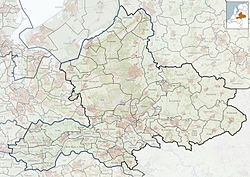Berg en Dal | |
|---|---|
 Schoonoord estate | |
Location in the province of Gelderland | |
| Coordinates: 51°49′N5°55′E / 51.817°N 5.917°E | |
| Country | Netherlands |
| Province | Gelderland |
| Municipality | Berg en Dal |
| Area | |
• Total | 7.85 km2 (3.03 sq mi) |
| Elevation | 87 m (285 ft) |
| Population (2021) [1] | |
• Total | 2,430 |
| • Density | 310/km2 (802/sq mi) |
| Time zone | UTC+1 (CET) |
| • Summer (DST) | UTC+2 (CEST) |
| Postal code | 6571 & 6572 [1] |
| Dialing code | 024 |
| Major roads | N841 |
Berg en Dal is a village in the Dutch province of Gelderland. It is located to the southeast of the city of Nijmegen. The village lies in the municipality of Berg en Dal.
Contents
One of the attractions in the village is the Africa Museum, which consists of a number of African villages, rebuilt on a 1:1 scale. Another attraction is the small amusement park of Tivoli.





